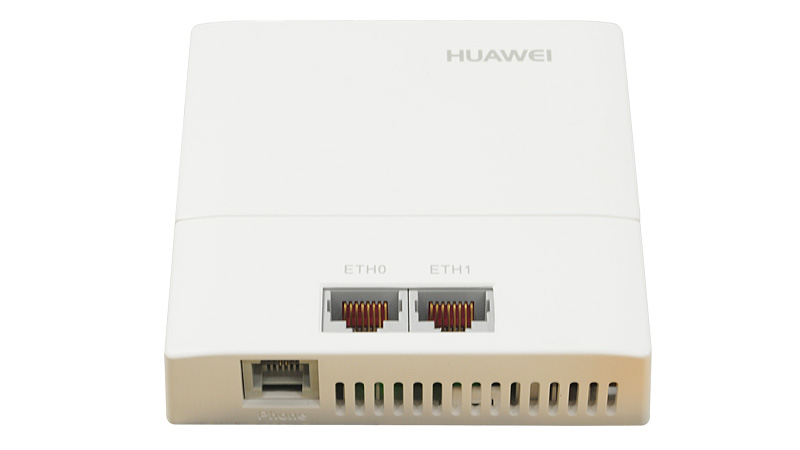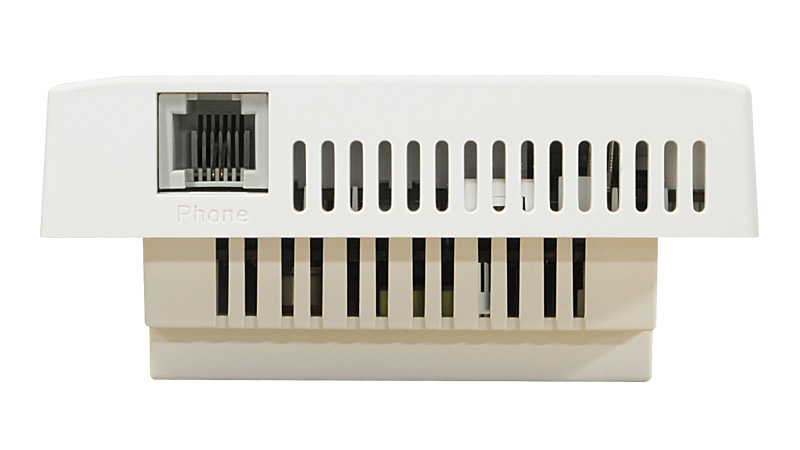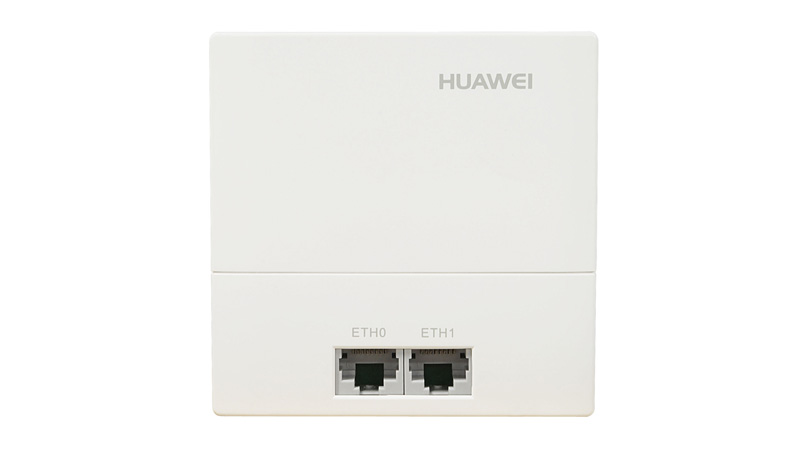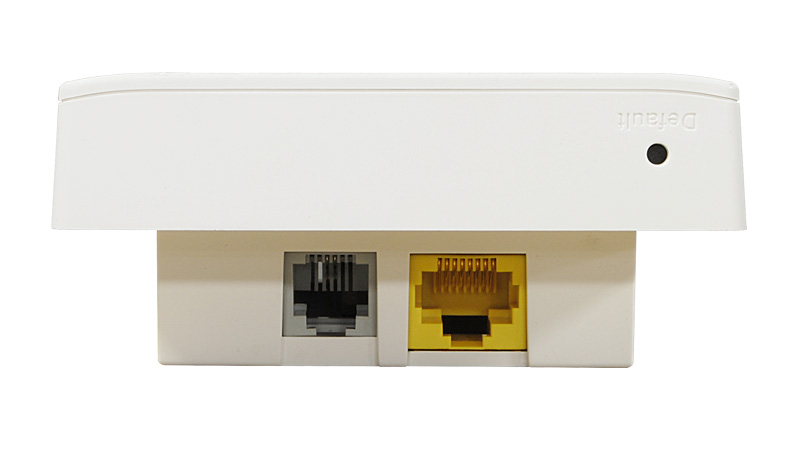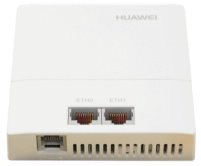Punto de acceso de la placa de pared AP2010DN
La placa de pared AP2010DN de nivel empresarial utiliza una placa de 86 mm y puede ser fácilmente instalada en una caja tipo 86. Soporta la banda de frecuencia de 2.4 GHz o 5 GHz y puede alternar fácilmente entre las dos bandas de frecuencia. El AP2010DN de Huawei dispone de conexiones alámbricas e inalámbricas, así como de conexiones telefónicas para hoteles, departamentos y edificios de oficinas.
• 2×2 MIMO (dos flujos espaciales).
• AP FIT.
• Alimentación a través de Ethernet.
• Antenas integradas.
This document describes the wall plate AP2010DN, including its appearance, ports, and indicators:
Appearance
Ports
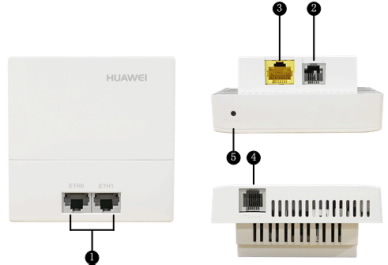
1. ETH0/ETH1: 10/100 Mbit/s interface, connects to the wired Ethernet.
2. Phone: Phone interface, connects to a traditional PSTN.
3. GE/PoE: 10/100/1000 Mbit/s interface, connects to the wired Ethernet. The interface can connect to a PoE power supply to provide power for APs.
4. Phone: Phone interface, connects to a POTS phone or modem device.
5. Default: Reset button, restores factory settings and restarts the AP if you hold down the button more than 3 seconds.
LED Indicators
| Type | Color | Status | Description |
|---|---|---|---|
| Default status after power-on | Green | Steady on | The AP is just powered on and the software is not started yet. |
| Software startup status | Green | Steady on after blinking once | After the system is reset and starts uploading the software, the indicator blinks green once. Until the software is uploaded and started, the indicator remains steady green. |
| Running status | Green | Blinking once every 2s (0.5 Hz) | The system is running properly, the Ethernet connection is normal, and STAs are associated with the AP. |
| Blinking once every 5s (0.2 Hz) | The system is running properly, the Ethernet connection is normal, and no STA is associated with the AP. The system is in low power consumption state. | ||
| Alarm | Green | Blinking once every 0.25s (4 Hz) | The software is being upgraded. After the software is uploaded and started, the AP enters the registration state and has not registered successfully with the AC yet. The AP registration fails (the CAPWAP link is disconnected). |
| Fault | Red | Steady on | A fault that affects services has occurred, such as a DRAM detection failure or system software loading failure. The fault cannot be automatically rectified and must be rectified manually. |
Highly reliable wireless access
- Complies with IEEE 802.11a/b/g/n.
- Supports 2 x 2 MIMO and provides a maximum rate of 300 Mbit/s.
- Supports Wi-Fi Multimedia (WMM) and priority mapping on the air interface and wired interface.
- Working on a single frequency and flexibly switches between the 2.4 GHz and 5 GHz frequency bands.
- Supports wired link integrity check.
- Supports roaming without service interruption.
- Supports 11n beamforming.
- Uses the latest 802.11n chip to provide higher performance and wider coverage.
Comprehensive user access control capability
- Supports access control lists (ACLs) and implements user access control based on the user group policy.
- Provides fine-grained bandwidth management for each user.
- Supports user isolation policies.
- Supports unified authentication on the AC.
- Identifies the device type according to the organizationally unique identifier (OUI) in the MAC address, user agent (UA) information in an HTTP packet, and DHCP options.
- The RADIUS server delivers packet forwarding, security, and QoS policies according to the device type carried in the RADIUS authentication and accounting packets.
High security
- Open system authentication
- WEP authentication/encryption
- WPA/WPA2-PSK authentication and encryption
- WPA/WPA2-802.1x authentication and encryption
- WAPI authentication and encryption
- Supports wireless intrusion detection system (WIDS), including rogue AP and STA detection, attack detection, STA/AP blacklist and whitelist.
Flexible networking and environment adaptability
- Has strong environment adaptability. The AP can automatically select the transmission rates, channels, and transmit power to adapt to various radio environments and avoid interference in real time.
- Adjusts bandwidth allocation based on the user quantity and environment to improve user experience.
- Identifies interference sources such as bluetooth devices, microwave ovens, cordless phones, ZigBees, game controllers, 2.4 GHz/5 GHz wireless video and audio devices, and baby monitors in Fit AP mode and works with eSight to locate interference sources and display spectrums.
Simple device management and maintenance
- Automatically goes online and loads the configuration, and supports plug-and-play (PnP).
- Supports batch upgrade.
- Allows real-time monitoring on the network management system (NMS) to facilitate remote configuration and fast fault location.
- Supports the Link Layer Discovery Protocol (LLDP) to implement automatic link discovery and obtain the network topology.
WLAN features
- Complies with IEEE 802.11a/b/g/n.
- Provides a maximum rate of 300 Mbit/s.
- Maximum ratio combining (MRC).
- Maximum-likelihood detection (MLD).
- Data unit aggregation, including A-MPDU (Tx/Rx) and A-MSDU (Rx only).
- Supports 802.11 dynamic frequency selection (DFS).
- Short GI in 20 MHz and 40 MHz modes.
- Priority mapping and packet scheduling based on a Wi-Fi Multimedia (WMM) profile to implement priority-based data processing and forwarding.
- Automatic and manual rate adjustment (the rate is adjusted automatically by default).
- WLAN channel management and channel rate adjustment.
- Automatic channel scanning and interference avoidance.
- Service set identifier (SSID) hiding.
- Signal sustain technology (SST).
- Unscheduled automatic power save delivery (U-APSD).
- Control and Provisioning of Wireless Access Points (CAPWAP).
- Automatic login.
Network features
- Compliance with IEEE 802.3u.
- Auto-negotiation of the rate and duplex mode and automatic switchover between the Media Dependent Interface (MDI) and Media Dependent Interface Crossover (MDI-X).
- SSID-based VLAN assignment.
- VLAN trunk on uplink Ethernet ports.
- 4094 VLAN IDs (1-4094) and a maximum of 8 virtual APs (VAPs) for each radio.
- AP control channel in tagged and untagged mode.
- DHCP client, obtaining IP addresses through DHCP.
- Tunnel data forwarding and direct data forwarding.
- STA isolation in the same VLAN.
- Access control lists (ACLs).
- Link Layer Discovery Protocol (LLDP).
- Uninterrupted service forwarding upon CAPWAP channel disconnection.
- Unified authentication on the AC.
- AC dual-link backup and VRRP hot backup.
- Native IPv6
- IPv4/IPv6 dual stack
- IPv6 Portal
- IPv6 SAVI
- IPv4/IPv6 ACL
QoS features
- Priority mapping and packet scheduling based on a Wi-Fi Multimedia (WMM) profile to implement priority-based data processing and forwarding.
- WMM parameter management for each radio.
- WMM power saving.
- Priority mapping for upstream packets and flow-based mapping for downstream packets
- Queue mapping and scheduling.
- User-based bandwidth limiting.
- Adaptive bandwidth management (the system dynamically adjusts bandwidth based on the number of users and radio environment to improve user experience).
Security features
- Open system authentication.
- WEP authentication/encryption.
- WPA/WPA2-PSK authentication and encryption.
- WPA/WPA2-802.1x authentication and encryption.
- WAPI authentication and encryption.
- Supports wireless intrusion detection system (WIDS), including rogue AP and STA detection, attack detection, STA/AP blacklist and whitelist.
- DHCP Snooping
- DAI(Dynamic ARP Inspection)
- IPSG(IP Source Guard)
Maintenance features
- Unified management and maintenance on the AC.
- Automatic login and configuration loading, and plug-and-play (PnP).
- Batch upgrade.
- Local AP management using Telnet.
- Real-time configuration monitoring and fast fault location using the NMS.
- System status alarm.
BYOD
- Identifies the device type according to the organizationally unique identifier (OUI) in the MAC address.
- Identifies the device type according to the user agent (UA) information in an HTTP packet.
- Identifies the device type according to DHCP options.
- The RADIUS server delivers packet forwarding, security, and QoS policies according to the device type carried in the RADIUS authentication and accounting packets.
Spectrum Analysis
- Identifies interference sources such as bluetooth devices, microwave ovens, cordless phones, ZigBees, game controllers, 2.4 GHz/5 GHz wireless video and audio devices, and baby monitors.
- Works with eSight to locate and perform spectrum analysis on interference sources.
Specifications
| Item | Description | |
|---|---|---|
Technical specifications |
Dimensions (H×W×D) | 45 mm x 86 mm x 86 mm |
| Weight | ≤0.2 kg | |
| System memory | 128 MB | |
Power specifications |
Power input | PoE power: PoE function in compliance with IEEE 802.3af and 802.3at |
| Maximum power consumption | 5.5 W NOTE: The maximum power consumption depends on local laws. | |
Environment parameters |
Operating temperature | 0°C to +40°C |
| Storage temperature | -40℃ to +70℃ | |
| Humidity | 5% to 95% (non-condensing) | |
| Altitude | –60 m to 4000 m | |
| Atmospheric pressure | 70 kPa to 106kPa | |
Radio Specifications
The AP2010DN support 2.4GHz & 5GHz, and can flexibly switch between the 2 GHz and 5 GHz frequency bands as required. Complies with IEEE 802.11a/b/g/n.
Huawei AP2010DN designed for enterprises uses an 86 mm plate in compliance with international standards and can be easily installed in an 86-type box. It is beautifully designed, with a built-in antenna, a hidden indicator, and a sliding panel. The AP2010DN provides comprehensive service support capabilities and features high security, simple network deployment, automatic AC discovery and configuration, and real-time management and maintenance.
It provides wired and wireless connections, as well as phone connections, applicable to hotels, apartments, and office buildings.
Fit AP typical networking:

In this networking, the AP functions as a fit AP. The AC is responsible for user access, AP go-online, AP management, authentication, routing, security, and QoS.

